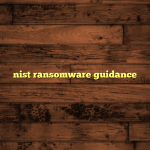NIST 8286: Integrating Cybersecurity Risk Management
Table of Contents:
- What Is NIST IR 8286?
- Why Is NIST IR 8286 Important?
- Core Concepts in NIST IR 8286
- Risk Scenario Definition
- Cybersecurity Risk Register (CSRR)
- Integration With Enterprise Risk Management
- Practical Steps Based On NIST IR 8286 Guidance
- How Does It Compare To Other Frameworks?
- FAQ
NIST IR 8286: Integrating Cybersecurity Risk Management
Is your organization treating cybersecurity as just an IT problem? NIST IR 8286 provides a better way! It offers a structured approach for including cybersecurity risk management into your broader company risk strategy.
What Is NIST IR 8286?
It is a collection of related documents. They are designed to assist groups in managing cybersecurity risk in harmony with enterprise-wide risk strategies. The series consists of several parts:
- IR 8286A – It gives attention to pinpointing and estimating cybersecurity risks.
- IR 8286B – That part includes prioritizing those risks for a suitable response.
- IR 8286C – It deals with aggregating CSRM information across the company.
- IR 8286D – This addresses business impact analysis linked to compromised IT resources.
Together, those documents provide a thorough guide for placing cyber risk factors into ERM processes.
Why Is NIST IR 8286 Important?
A major obstacle for many organizations is the gap between the traditional ERM – which covers financial risks, operational risks, as well as risks to reputation – and specific cybersecurity anxieties. Governing boards along with regulators are progressively expecting cyber risks to be quantified in a similar manner as other business risks. NIST IR 8286 comes in handy, for it pushes forward measurable and defensible evaluations of cyber risk. This can be plugged into broader organizational decision-making. By establishing cyber threats as a piece of an organization’s overall risk situation as opposed to separate IT concerns, it encourages teamwork between security departments along with top leadership. This arrangement makes choices on the allocation of resources better. Moreover, it upholds effective responses custom-made to business priorities.
Core Concepts in NIST IR 8286
What are the main building blocks of this framework?
Risk Scenario Definition
The preliminary drafts of the standard explain the use of assets, threats, vulnerabilities (or methods), with consequences as core components as you define a “risk scenario.” Nevertheless, there’s been comments advising to replace “vulnerability” with “method.” Method captures attacker behavior patterns more precisely, rather than merely pinpointing technical weaknesses. This replacement enables analysts to think about many vulnerabilities tapped together in a single attack method. It makes scenarios steadier as time passes.
Cybersecurity Risk Register (CSRR)
NIST IR 8286 advises a Cybersecurity Risk Register. It is a centralized tool, which is a structured place to keep documented cyber risks with details. Such details include priority level, steps taken, planned responses, owners accountable for lessening efforts, status updates on those actions, together with similar information. The CSRR has many purposes:
- It keeps tabs on ongoing assessment outcomes.
- It encourages communication between departments.
- It helps in prioritizing finite resources based on unwavering standards.
- It supplies useful documentation for audits or regulatory reviews.
Keeping this register active guarantees that budding threats are caught immediately. Also, it shows shifts in the organization or in strategy.
Integration With Enterprise Risk Management
NIST emphasizes that the words “organization” or “enterprise” are commonly employed reciprocally. Although, they usually refer to one thing or the other: whether it is any entity or particularly one that includes a ranked structure. That includes leaders that are bearing fiduciary responsibility. The guideline spurs the use of uniform methods throughout all levels – from solitary systems up through whole enterprises – to guarantee reliable prioritization also reporting. This integration brings about:
- Cybersecurity tasks flow right into ERM discussions.
- Business impact studies take into consideration confidentiality, integrity, next to availability losses from resources that are crucial to operations.
- Decision-makers get aggregated insights. The insights combine technical conclusions with strategic meaning.
Practical Steps Based On NIST IR 8286 Guidance
Based on official documents and actual implementations, here’s how groups typically use these guidelines:
- Establish Context & Strategy
Determine your company’s cravings for cyber-related damages in line with all-embracing corporate objectives. - Identify Risks
Make use of asset inventories matched with threat intelligence along with weakness/method analysis to assemble comprehensive scenarios. Describe possible attacks. - Estimate Risks
Assess possibilities along with effects, in consideration of both straight harms (e.g., data loss) in addition to roundabout effects such as damage to reputation. - Document In CSRR
Note each pinpointed scenario in addition to its priority ranking depending on assessed seriousness – delegate ownership – monitor mitigation plans as well as statuses continuously. - Prioritize Responses
Opt for fitting controls, in consideration of cost-effectiveness with respect to recurring exposure – bring up to date register fittingly, mirroring selected strategies for each scenario. - Aggregate & Monitor Enterprise-Wide
Consolidate data from diverse units or departments, making sure leadership preserves understanding of circumstances concerning changing threat situations with reference to business purposes. - Conduct Business Impact Analysis
Assess whatever takes place if critical systems give way partially or fully as a result of compromise. This informs the effort of recovery planning included inside ERM frameworks. - Communicate Effectively Across Stakeholders
Make use of uniform language together with reporting layouts thus nontechnical managers grasp give-and-takes implicated within disparate reaction options without forfeiting fine points about uncertainty factors ingrained within estimation processes. - Review & Adjust Regularly
As novel intelligence materializes and also organizational priorities alter over time, bring up to date suppositions underpinning estimates together with scenarios mirrored inside CSRRs. That guarantees relevance remains elevated throughout shifting environments.
How Does It Compare To Other Frameworks?
Frameworks such as ISO/IEC 27001 put focus on setting up security controls in and of themselves. On the other hand, others like COSO cover governance, extensively. NIST IR 8286 solely fills the gap related to *how* you find, arrange in order, along with supervise *cybersecurity* in an *enterprise-wide* setting. It gives importance to measurable outcomes connected openly back to business objectives rather than strictly technical compliance checklists. It is a great addition to other standards by arranging documentation, as well as dynamic cyber-risk information tracking by means of registers. These registers are securely arranged in accordance with overarching ERM policies, which are already recognized at executive levels. — In short: NIST IR 8286 gives down-to-earth as well as all-inclusive counsel aiding organizations to move from separate IT security towards developed integration. In it, cybersecurity turns into an essential element of day-to-day decision-making for the enterprise concerning all kinds of risk exposure. Financials are included. Clear paperwork practices such as keeping up-to-date Cybersecurity Risk Registers connected directly underneath corporate governance structures support this process.
FAQ
What is the main goal of NIST IR 8286?
The main goal is to guide organizations on how to integrate cybersecurity risk management into their broader enterprise risk management framework, ensuring cyber risks are considered alongside other business risks.
Who should use NIST IR 8286?
Any organization looking to improve their cybersecurity risk management practices and align them with their business goals.
How does NIST IR 8286 differ from other cybersecurity frameworks?
It uniquely emphasizes how to identify, prioritize, next to manage cybersecurity within an enterprise-wide context. It focuses on measurable outcomes linked directly to business goals, rather than just technical compliance.
Resources & References:
- https://www.fairinstitute.org/blog/feedback-on-nist-ir-8286-drafts
- https://nvlpubs.nist.gov/nistpubs/ir/2025/NIST.IR.8286B-upd1.pdf
- https://nvlpubs.nist.gov/nistpubs/ir/2025/NIST.IR.8286Ar1.ipd.pdf
- https://www.saltycloud.com/blog/it-security-risk-register/
- https://nvlpubs.nist.gov/nistpubs/ir/2025/NIST.IR.8286r1.ipd.pdf





